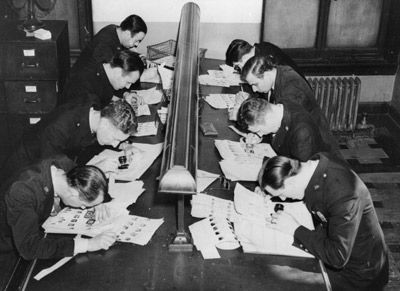Other Biometrics
Fingerprinting isn't the only way to catch a criminal, or perform one of the many other biometrics-driven technologies now available. Eye scans, voice fingerprints and even DNA are now providing means of identification, as well as access to everything from ATMs to cars.
Here are just a few of the biometrics you might be using in the near future:
Advertisement
- Eye scans: Both the retina (the layer of tissue in the back of the eye that converts light into nerve signals) and the iris (the colored part of the eye) have unique characteristics that make them highly accurate biometrics. For a retinal scan, a person holds his or her eye close to the scanning device for 10 to 15 seconds while a low-intensity light and sensor analyze distinct patterns. Although retinal scans are used in very high-security institutions like power plants and the military areas, they are currently too expensive to be practical for widespread use. Irises have more than 200 different unique identifying characteristics (about six times more than fingerprints) ranging from rings to freckles. Iris identification systems take only about two seconds to scan the iris and look for patterns. They're used in some prisons and a few airports.
- Ear scans: Ears are unique in size, shape and structure. Scientists use these traits to develop biometric scans of the ear. In ear scans, a camera creates an image of the ear that is analyzed for identifying characteristics.
- Voice fingerprints: Every time a new Osama bin Laden tape comes out, the FBI Audio Lab in Quantico,Va. runs it through a voice analyzer, which captures the frequency, intensity and other measurements to determine whether the tape is authentic. These so-called "voice fingerprints" aren't as definitive as fingerprints or DNA, but they can help distinguish one person from another.
- DNA fingerprints: Every individual has unique DNA. While you can change your appearance, you can't change your DNA. Because of this, scientists are starting to use DNA analysis to link suspects to blood, hair, skin and other evidence left at crime scenes. DNA fingerprinting is done by isolating the DNA from human tissues. The DNA is cut using special enzymes, sorted and passed through a gel. It's then transferred to a nylon sheet, where radioactive probes are added to produce a pattern -- the DNA fingerprint.
Some of these technologies are still in development, so it isn't yet known which is the most effective form of identification. And of course, some types of biometrics are better suited for specific tasks than others. For example, voice fingerprints are most appropriate for phone financial transactions.
To find out more about fingerprinting, biometrics and other tales of true crime, look over the links below.
Related HowStuffWorks Articles
More Great Links
Sources
- American Psychological Association. "To Catch a Thief: The Psychology of Fingerprints." http://www.psychologymatters.org/galton.html.
- Biometrics.gov. "Introduction to Biometrics." http://www.biometrics.gov/ReferenceRoom/Introduction.aspx.
- Encyclopedia Britannica. "Fingerprinting." http://search.eb.com/eb/article-9034291.
- Encyclopedia Britannica. "Police." http://search.eb.com/eb/article-260948.
- FBI. "Integrated Automated Fingerprint Identification System." http://www.fbi.gov/hq/cjisd/iafis.htm
- FBI. "Taking Legible Fingerprints." http://www.fbi.gov/hq/cjisd/takingfps.html
- FBI. "What we Do." http://www.fbi.gov/kids/k5th/whatwedo2.htm
- Hillsborough County Sheriff's Office. "Fingerprinting Identification." http://www.hcso.tampa.fl.us/SOD/ffingerprintid.htm
- International Biometric Group. "Henry Classification System," 2003.
- Iowa State University. "DNA Fingerprinting in Human Health and Society." http://www.biotech.iastate.edu/biotech_info_series/bio6.html.
- Jackall, Robert. "Tales Told by Loops, Whorls, and Ridges." Science, September 7, 2001, Vol. 293, pgs. 1771-1772.
- Komarinski, Peter. "Automated Fingerprint Identification Systems." Elsevier, Academic Press, 2004.
- National Center for State Courts. "Fingerprint." http://ctl.ncsc.dni.us/biomet%20web/BMFingerprint.html.
- National Center for State Courts. "Retinal Scan." http://ctl.ncsc.dni.us/biomet%20web/BMRetinal.html
- National Institutes of Health. "Cases." http://www.nlm.nih.gov/visibleproofs/galleries/cases/vucetich.html.
- New York State Division of Criminal Justice Services. "Fingerprint Classification Systems Compared." http://criminaljustice.state.ny.us/ojis/history/ph_am_hn.htm.
- Scanlon, Lisa. "Fingerprinting's Finger-Pointing Past." Technology Review, June 2003, Vol. 106, pg. 80.
- The Boston Channel. "Criminals Cutting Off Fingerprints To Hide IDs." http://www.thebostonchannel.com/news/15478914/detail.html



